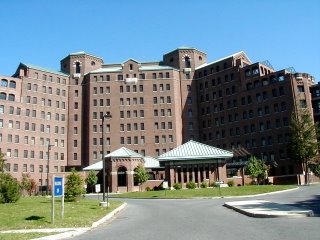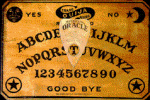
"The film which you are about to see is an account of the tragedy that befell a group of five youths, in particular Sally Hardesty and her invalid brother, Franklin. It is all the more tragic in that they were young. But, had they lived very, very long lives, they could not have expected nor would they have wished to see as much of the mad and macabre as they were to see that day. For them an idyllic summer afternoon drive became a nightmare.
The Events of that day were to lead to the discovery of one of the most bizarre crimes in the annals of American history. The Texas Chainsaw Massacre." - August 18th, 1973
10% fact 90% fiction.
The film, like the films Psycho, Deranged and The Silence of the Lambs, was loosely inspired by Ed Gein. Gein did wear human skin, but he acted alone and did not use a chainsaw. Although the film's opening would have one believe that the events are factual, it is merely a scare tactic, called the false document technique, to frighten the audience. Libraries in Burkburnett, Texas and nearby Wichita Falls regularly receive requests for copies of newspaper articles related to the false actual events.
CLICK HERE FOR MORE INFO ON ED GAIN "Warning Very Graphic"
Some Chainsaw Trivia
-Director Tobe Hooper claims to have got the idea for the film while standing in the hardware section of a crowded store. While thinking of a way to get out through the crowd, he spotted the chainsaws.
-The financing for this film came from the profits of Deep Throat, a previous film the production company had financed.
-The film was originally entitled "Headcheese", but was changed at the last minute. -Alternate titles included "Leatherface" and "Stalking Leatherface".
-The narrator at the beginning of the film is John Larroquette, famous for playing the Night Court character Dan Fielding.
-The soundtrack contains the sounds an animal would hear inside a slaughterhouse.
-The dead armadillos in the first scene after the title sequence, and the nest of daddy longlegs in the abandoned house, were found by chance when location-scouting. Outtake footage shows the former scene would originally have involved a dead dog by the roadside.
-The film was shot in chronological order.
-The DVD commentary reveals that Paul Partain, who played Franklin, genuinely annoyed Marilyn Burns. Partain explains that this is because he stayed in character for the duration of the shoot as he was worried he might not be able to get back into it if he stopped, and wasn't surprised that the others wouldn't want to hang around someone that "whiney". Consequently, Burns "didn't have to do much acting" in scenes showing Sally's frustration with Franklin[5].
-On the DVD commentary Hooper states the skeletons in Leatherface's house were real human skeletons purchased from India. These bones were piled and burnt by a stagehand at the end of filming.
-Actress Teri McMinn, whose character was hung up on a meat hook, was actually held up by a nylon cord that went between her legs, causing her a great deal of pain.
When Leatherface is chasing Sally (Marilyn Burns) through the bushes, she actually cut herself badly on them, and a lot of the blood on her is real.
-During the dinner scene towards the end of the film, when Leatherface cuts Sally's (Marilyn Burns) finger, he actually does cut her finger. The prop knife with the fake blood mechanism would not work properly, and the shot was being continually ruined. The crew and actors were working inside the house under conditions that were truly horrifying, temperatures well over 100 degrees and surrounded by rotting meat. In frustration, Burns urged the actor to just cut her finger for real, just so they could get the shot over with.
-A Cue Card is showing in the background with the name "Edwin" sketched on it during the Grandpa feeding scene.
-After getting into the old-age makeup, John Dugan decided that he did not ever want to go through the process again, meaning that all the scenes with him had to be filmed in the same session before he could take the makeup off. This took about 36 hours, during a heat wave where the average temperature was over 100 degrees, with a large portion of it spent filming the dinner scene, sitting in a room filled with dead animals and rotting food.
-Edwin Neal (who played the Hitchhiker) said of the dinner scene, "Filming that scene was the worst time of my life... and I had been in Vietnam, with people trying to kill me, so I guess that shows how bad it was." He also said that he might kill director Tobe Hooper if he ever saw him again.
-Hooper used a stunt double for Sally's leap through the window; all the same, Marilyn Burns actually hurt herself shooting the insert of her falling to the ground.
-A family was actually living in the house that served as the Sawyer family house in the later half of the movie. They rented out their house to the film crew and continued to stay there during the entire shoot. Since the film was released, the location used as the Sawyer family house has changed completely. The land where the house used to stand on a hill has been cut in two for a major freeway; there is no sign there ever was a house there. The house itself has been relocated and is used as a restaurant in Kingsland, Texas.
The title is actually spelled incorrectly as Tobe Hooper thought that "chainsaw" was two words.
-Leatherface
-The creators wanted to make Leatherface talk, but Gunnar Hansen declined, thinking it would make him seem too human. Leatherface was intended to be a subhuman character who only spoke in gibberish, his "lines" in the script having side notes indicating what he was trying to say. Tobe Hooper allowed Gunnar Hansen to develop Leatherface as he saw fit (under his supervision). Hansen decided that Leatherface was mentally retarded and never learned to talk properly, so he went to a school for the mentally challenged and watched how they moved and listened to them talk to get a feel for the character.
-Leatherface's teeth were prostheses made especially for Gunnar Hansen by his dentist.
-The chainsaw used in this film was a Poulan 306A, with a piece of black tape covering the Poulan logo in order to avoid a possible lawsuit.
-Gunnar Hansen hit his head on doorways and other objects several times during the shoot because the Leatherface mask severely limited his peripheral vision and the three inch heels made his 6'4" frame too high to clear all obstacles.
-Gunnar Hansen wore three inch heels so that he was taller than all the cast and had to duck to get through the doorways in the slaughterhouse. However, even in these lift-boots, Gunnar Hansen could run faster than Marilyn Burns, and thus had to do random things when chasing her through the woods in order to avoid catching her up (in one head-on shot he starts slicing up tree branches in the background).
-Due to the low budget, Gunnar Hansen had only one shirt to wear as Leatherface. The shirt had been dyed, so it could not be washed; Hansen had to wear it for four straight weeks of filming in the Texas summer. By the end of the shoot no one wanted to eat lunch with Hansen because his clothing smelled so bad.
-The close-up of Leatherface cutting his leg on the chainsaw was the last shot to be filmed; the actor was wearing a metal plate over his leg, which was then covered with a piece of meat and a blood bag.
More on the TEXAS CHAINSAW MASSACRE
WWW.SNOPES.COM History, Ed Gain, Quotes from Tobe Hooper, Gunner Hansen
WWW.TEXASCHAINSAWMASSACRE.NET History, fan clubs, Film locations, Pictures, Interviews...and a lot more.
THE SAW IS FAMILYCHOP TOPS BBQA Bonus
THE REAL TEXAS CHAINSAW MASSACRE starring George Bush....Made by Greenpeace
TAGS
entertainmentmoviesHorrorhorror movies





























